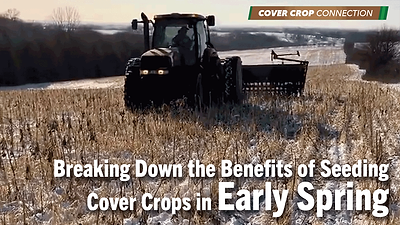University of Nebraska–Lincoln researchers are leading a study of how a targeted restoration of perennial grasses amid cropland could bring about a variety of benefits, ranging from reduction in water and fertilizer use to expansion of wildlife habitat to encouragement of new bioenergy industry.
The four-year, $4 million project will be conducted on University of Nebraska research plots and 12 to 15 on-farm sites in the Republican River Basin in west central and western Nebraska, said Daren Redfearn, the Husker forage systems specialist leading the work.
The project, Expanding the Conversion of Habitat in the Northern Great Plains Ecosystem, or EXCHANGE, has its genesis in a U.S.Department of Energy goal to reduce water and fertilizer use on crops by 25%. EXCHANGE is funded through the DOE’s Office of Energy Efficiency and Renewable Energy.
“We said the easiest way to do that would be to just not grow on 25% of the area under those pivots and not fertilize it and not water it,” Redfearn said.
So researchers will plant what some call “prairie strips” on less productive areas within cropland — species of native perennial warm-season grasses, including switchgrass, big bluestem and Indiangrass. They also will be planted in corners of irrigated areas that are not easily reached by pivots.
Establishing perennial grasses in their native habitat is nothing new, Redfearn said.
“What makes our proposed technology unique and innovative is using limited irrigation on native perennial tallgrasses within irrigated row-cropped landscapes,” he said.
Researchers believe that limited irrigation of these grasses, using much less water than adjacent crops, ultimately will produce more biomass than other warm- and cool-season grasses typically planted in the region.
Potential impacts of this approach include:
- Reduction of landscape-scale irrigation water use and improved groundwater sustainability
- Reduction of fertilizer and herbicide inputs and improved nutrient retention and farm net returns
- Increased soil carbon and reduction of greenhouse gas emissions to help mitigate climate change and provide additional revenue streams
- Increased biodiversity by restoring wildlife habitat, primarily for birds and pollinator insects
- Encouragement of a new bioenergy market for growers
“This project could serve as a large-scale regional model for altering the culture of agriculture while providing economic opportunity for family farms and serving as a model system for the emerging bioeconomy,” Redfearn said.
Ultimately, the approach could lead to construction of new biorefineries in the region to process the grasses.
“You can’t haul those bioenergy grasses much further than 40 or 50 miles and make that cost-effective,” Redfearn said. “But even if that doesn’t happen, there still are plenty of livestock in that area that can utilize those grasses. They’ll get used one way or another.”
The project will also produce an all-encompassing life cycle economic analysis.
“We need to identify a monetary value to all these ecosystem services. A lot of people have an interest in that, but no one’s figured out how to do it,” Redfearn said. “We have an opportunity to assign some value” to the individual impacts of the research that will help determine its feasibility for expansion.
Other Nebraska investigators include Andrew Little, assistant professor in the School of Natural Resources; Jay Parsons, professor of agricultural economics; and Julie Peterson, associate professor of entomology. The university also is partnering with the U.S. Department of Agriculture’s Agricultural Research Service and Argonne National Laboratory in Lemont, Illinois.



